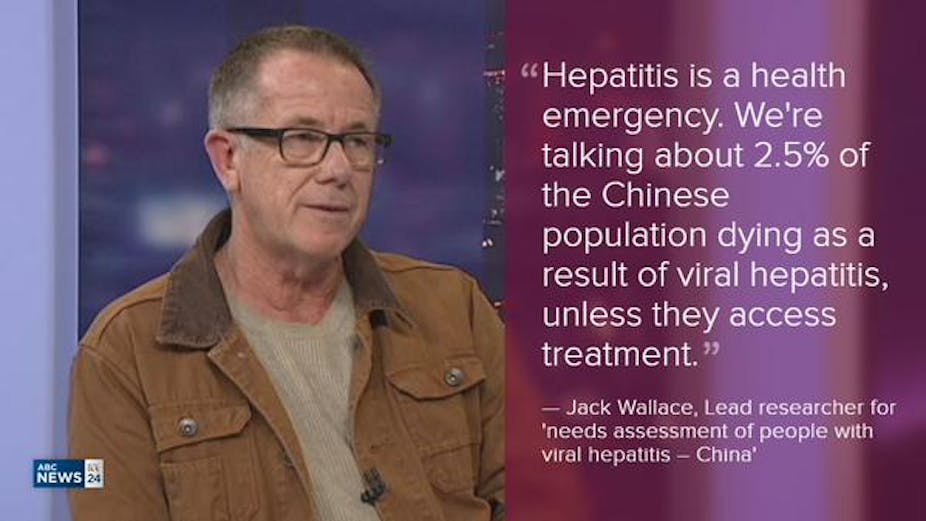Tuesday 28th July is World Hepatitis Day. Guest columnist Jack Wallace from ARCSHS at La Trobe University tells us why it’s time for action on viral hepatitis.
The Australian theme for this year’s World Hepatitis Day is ‘It’s Time for Action on Viral Hepatitis. Time for Action – Test, Check, Treat’.
The global impact of viral hepatitis
According to Hepatitis Australia almost half a million Australians live with hepatitis B or hepatitis C and up to 1,000 Australians die each year as a result of these infections. Across the world, viral hepatitis causes 1·44 million deaths every year – a figure comparable to deaths from conditions such as HIV/AIDS (1·46 million), tuberculosis (1·20 million) and malaria (1·17 million).
The statistics for the Asia Pacific region are grim: 76% of the global population with viral hepatitis live in this region, with the number of people dying from viral hepatitis outnumbering the combined deaths from HIV, malaria, and tuberculosis.
Clearly a successful global response to viral hepatitis depends on a successful response to the epidemic in Asia. At a global level, the World Health Organisation (WHO) is currently consulting on the development of the Global Health Sector Strategy on Viral Hepatitis, 2016-2021, with input being sought by the WHO into the Regional Action Plan for Viral Hepatitis in the Western Pacific.
Even the best action plans will have little impact unless resources are made available to implement the strategies they recommend. A commentary in Lancet Infectious Diseases I co-authored with colleagues from the Coalition to Eradicate Hepatitis in Asia Pacific noted that financial investment in the response to viral hepatitis is inadequate at a global level. Even in the USA, where hepatitis C is at least five times more prevalent than HIV, little funding has been directed to improving prevention, care, or research.
The Sustainable Development Goals, the successor to the Millennium Development Goals, are currently under development by the United Nations. A suggested target is to end the epidemics of AIDS, tuberculosis, malaria, and neglected tropical diseases by 2030 and to combat hepatitis, water-borne diseases, and other communicable diseases. While it is heartening to see a target focusing on viral hepatitis, it is not enough simply to seek to combat hepatitis. Global agencies, such as the World Bank and global philanthropic organisations, need to acknowledge the growing evidence about the significant burden of disease caused by viral hepatitis and dedicate resources commensurate to the need.
We need to tackle viral hepatitis as one of the big four infectious diseases of our time.
Remarkable advances in reducing the transmission of hepatitis B have occurred over the past decade. The successful implementation of the hepatitis B vaccination programme in China has effectively prevented up to 30 million hepatitis B infections and 4.3 million deaths of children born after 1992.
We need to continue efforts to stop the transmission of viral hepatitis, but we cannot ignore the estimated 150 million people in China already infected with chronic viral hepatitis. The increasing numbers of deaths related to the infections means ensuring that people with chronic hepatitis are effectively managed by the health care system. We recently released our Needs assessment of people with viral hepatitis—China, showing that people were usually diagnosed with viral hepatitis through educational or employment institutions, and notified by a teacher or human resources personnel. Little information was provided to people about their infection. Decisions about treatment were often based on economic rather than clinical factors.
What does this mean for Australia?
Despite few economic barriers to accessing treatment, and the existence of a national response to viral hepatitis, less than 5% of people with viral hepatitis have ever accessed clinical services. This is particularly important for Chinese born Australians, who make up the largest community of people with hepatitis B in Australia. Without better access to information they may never access the testing and treatment services they need, leading to significant morbidity and mortality from liver disease.
Ensuring all Australians with chronic hepatitis B and C are diagnosed, undergo regular liver check-ups and receive appropriate treatment is critical to avert a liver disease crisis in Australia.
‘It’s Time for Action on Viral Hepatitis. Time for Action – Test, Check, Treat’.
Jack Wallace is a Research Fellow at the Australian Research Centre in Sex, Health and Society at La Trobe University.
Click here to watch Jack Wallace speaking with Beverley O'Connor on The World, ABC News 24

